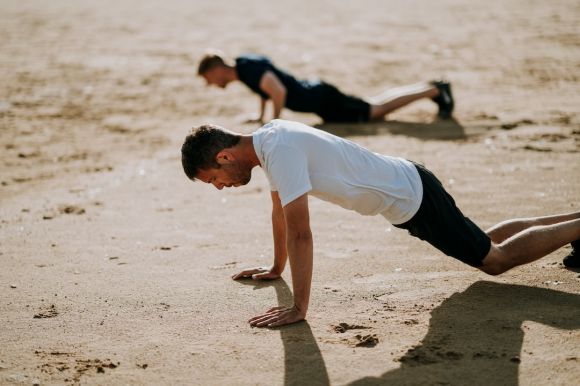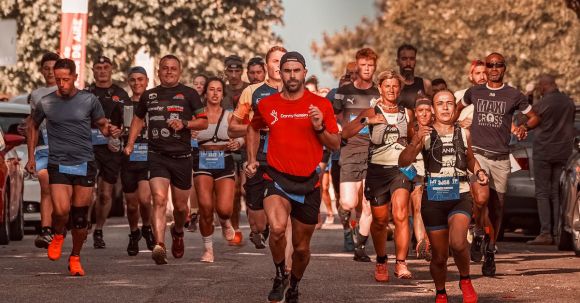Are you tired of the same old fitness routine? Do you struggle to find the time to go to the gym? If so, Fit On's online personal training program may be just what you need to take your fitness journey to new heights.
Author: fit-on
Flexibility is an important component of overall fitness. It allows us to move freely and perform daily activities without pain or discomfort. Many people believe that flexibility can only be achieved through stretching exercises, but recent research suggests that strength training can also play a significant role in improving flexibility. In this article, we will explore the relationship between strength training and flexibility and discuss how incorporating strength training into your routine can help you achieve better overall flexibility.
Understanding Flexibility
Before we delve into the benefits of strength training for flexibility, it is important to understand what flexibility actually means. Flexibility refers to the range of motion in a joint or group of joints. It is influenced by various factors, including muscle length, joint structure, and connective tissue elasticity. The more flexible a person is, the greater their ability to move their joints through a full range of motion.The Role of Strength Training
Traditionally, stretching exercises have been the go-to method for improving flexibility. However, recent studies have found that strength training can also have a positive impact on flexibility. When you engage in strength training exercises, you are not only building muscle strength but also improving your joint stability and mobility. This increased stability and mobility can lead to improved flexibility over time.Strength Training and Muscle Length
One way strength training helps improve flexibility is by increasing muscle length. As you perform strength training exercises, your muscles undergo microtears, which then heal and adapt to become stronger and longer. This lengthening of muscles can contribute to improved flexibility. For example, performing exercises that target the hamstrings can lead to increased muscle length, allowing for greater flexibility in movements such as forward folds or splits.Strength Training and Joint Mobility
In addition to increasing muscle length, strength training can also improve joint mobility. When you engage in strength training exercises, you are challenging your joints to move through a full range of motion. Over time, this can lead to increased joint mobility and flexibility. For example, performing squats can improve hip mobility, which can then translate to better flexibility in movements such as deep squats or lunges.Incorporating Strength Training for Flexibility
Now that we understand the benefits of strength training for flexibility, let's explore how you can incorporate it into your routine. It is important to note that strength training should not replace stretching exercises but rather complement them. By combining strength training with stretching, you can maximize your flexibility gains. Start by incorporating strength training exercises that target the muscles and joints you want to improve flexibility in. For example, if you want to improve hamstring flexibility, include exercises such as deadlifts or hamstring curls in your routine. Aim to perform these exercises at least two to three times a week, gradually increasing the intensity and volume over time. In addition to targeting specific muscles and joints, it is also important to engage in full-body strength training exercises. These exercises can help improve overall muscle strength and joint stability, which in turn can contribute to better flexibility. Examples of full-body strength training exercises include squats, lunges, push-ups, and rows.Conclusion
Flexibility is a crucial aspect of overall fitness, and strength training can play a significant role in improving it. By incorporating strength training exercises that target specific muscles and joints, you can increase muscle length and joint mobility, leading to improved flexibility. Remember to combine strength training with stretching exercises for maximum flexibility gains. So, if you're looking to enhance your flexibility, why not give strength training a try? Your body will thank you.
In the midst of the ongoing pandemic, it has become more important than ever to prioritize our health and strengthen our immune systems. While social distancing and staying at home have become the new normal, it doesn't mean that we have to compromise on our fitness levels. In fact, one of the most effective ways to boost our immune system is through regular home workouts. In this article, we will explore the benefits of home workouts and provide you with some tips on how to get started.
Why are home workouts beneficial?
1. Convenience: One of the key advantages of home workouts is the convenience they offer. You can exercise whenever you want, without the hassle of commuting to the gym or adhering to a strict schedule. This flexibility allows you to fit exercise into your daily routine, making it more likely that you will stick to your fitness goals. 2. Cost-effective: Gym memberships can be expensive, but with home workouts, you can save a significant amount of money. There is no need to invest in expensive equipment or pay monthly fees. Many effective exercises can be done using just your body weight or simple equipment like resistance bands or dumbbells. 3. Privacy: Some people may feel self-conscious about exercising in public or being judged by others at the gym. Home workouts provide a private and comfortable environment where you can exercise without any distractions. This can boost your confidence and make your workouts more enjoyable.Tips for effective home workouts
1. Plan your workouts: Before starting your home workouts, it is important to have a plan in place. Set specific goals and create a workout schedule that suits your lifestyle. This will help you stay focused and motivated. 2. Mix up your routine: Variety is key to keeping your workouts interesting and challenging. Incorporate a mix of cardiovascular exercises, strength training, and flexibility exercises. This will ensure that you are targeting different muscle groups and improving overall fitness. 3. Use online resources: The internet is a treasure trove of workout routines and instructional videos. Take advantage of online fitness programs, mobile applications, and YouTube channels that offer a wide range of home workout options. This will help you stay motivated and provide guidance on proper form and technique. 4. Stay consistent: Consistency is crucial when it comes to reaping the benefits of home workouts. Aim for at least 150 minutes of moderate-intensity exercise or 75 minutes of vigorous exercise per week, as recommended by health experts. Break it down into manageable chunks and make it a habit to exercise regularly. 5. Listen to your body: While pushing yourself during workouts is important, it is equally important to listen to your body and avoid overexertion. Pay attention to any pain or discomfort and modify exercises accordingly. Rest and recovery are also essential for optimal muscle growth and immune system function.Boosting your immune system with home workouts
Regular exercise has been shown to enhance the immune system, reducing the risk of infections and improving overall health. When you engage in moderate-intensity exercise, such as brisk walking or cycling, it increases the circulation of immune cells in your body, helping them to detect and fight off harmful pathogens. Additionally, exercise promotes the release of endorphins, which can reduce stress and improve mood, further enhancing immune function. In conclusion, home workouts offer a convenient, cost-effective, and private way to boost your immune system. By incorporating regular exercise into your routine and following the tips outlined in this article, you can improve your overall health and well-being. So, why wait? Start your home workout journey today and reap the benefits of a stronger immune system.
Sports-specific training is a crucial aspect of becoming a top athlete in any sport. It involves tailoring your training routine to focus on the specific demands and skills required in your chosen sport. By incorporating sports-specific training into your regimen, you can enhance your performance, reduce the risk of injury, and take your game to the next level. In this article, we will explore the importance of sports-specific training and provide tips on how to incorporate it into your training routine.
Understanding the Importance of Sports-Specific Training
Sports-specific training is designed to mimic the movements, skills, and physical demands of your sport. By training in a way that closely replicates the actions and requirements of your sport, you can improve your performance in a more targeted and effective manner. This type of training helps to develop the specific muscles, movement patterns, and energy systems needed to excel in your game.Benefits of Sports-Specific Training
1. Enhanced Performance: Sports-specific training allows you to focus on the skills and movements that are most important for your sport. By dedicating time to these specific areas, you can improve your technique, speed, agility, and overall performance. 2. Reduced Injury Risk: By training in a way that mimics the movements and demands of your sport, you can strengthen the muscles, tendons, and ligaments that are most susceptible to injury. This type of training also helps to improve balance and proprioception, which can further reduce the risk of injury. 3. Improved Mental Toughness: Sports-specific training often involves high-intensity drills that push you to your limits. By consistently pushing yourself in training, you can develop mental toughness and the ability to perform under pressure.Tips for Incorporating Sports-Specific Training
1. Analyze Your Sport: Take the time to analyze the specific movements, skills, and physical demands of your sport. Identify the areas where you need improvement and focus your training on those aspects. 2. Design a Targeted Training Plan: Once you have identified the areas for improvement, design a training plan that targets those specific areas. Incorporate exercises and drills that closely mimic the movements and demands of your sport. 3. Work on Sport-Specific Skills: Dedicate time to practicing the skills that are essential for your sport. Whether it's shooting, passing, dribbling, or tackling, focus on perfecting these skills through repetition and targeted drills. 4. Include Strength and Conditioning Exercises: In addition to sport-specific skills, it is important to incorporate strength and conditioning exercises into your training routine. Focus on exercises that target the muscles and energy systems used in your sport. 5. Train in Game-Like Conditions: To further enhance sports-specific training, try to replicate game-like conditions as much as possible. This could involve practicing on the same surface, using the same equipment, or simulating game situations during training. 6. Seek Professional Guidance: Consider working with a sports coach or trainer who specializes in your sport. They can provide expert guidance, personalized training plans, and valuable feedback to help you excel in your game.Conclusion: Take Your Game to the Next Level
Sports-specific training is a game-changer for athletes looking to excel in their chosen sport. By focusing on the specific skills, movements, and physical demands of your sport, you can enhance your performance, reduce the risk of injury, and reach new heights in your game. Incorporate these tips into your training routine and watch as you excel in your sport like never before.
In the world of sports, athletes are constantly seeking an edge over their competition. Whether it's speed, strength, agility, or endurance, they are always on the lookout for ways to improve their performance. One key aspect that can make a significant difference is sports-specific training. By tailoring their workouts to mimic the demands of their sport, athletes can enhance their skills and become dominant competitors. In this article, we will explore the importance of sports-specific training and provide some tips on how to incorporate it into your routine.
UNDERSTANDING SPORTS-SPECIFIC TRAINING
Sports-specific training involves designing workouts and exercises that closely resemble the movements and requirements of a specific sport. It aims to improve an athlete's overall performance by enhancing the specific skills needed for their chosen discipline. This type of training goes beyond general fitness and focuses on the specific demands of the sport, such as the techniques, energy systems, and muscle groups involved.THE BENEFITS OF SPORTS-SPECIFIC TRAINING
1. IMPROVED SKILL DEVELOPMENT: By mimicking the movements and techniques used in your sport, sports-specific training helps you develop the necessary skills more effectively. For example, if you are a tennis player, incorporating drills that focus on footwork, agility, and racket control will help you become a more skilled and dominant player on the court. 2. ENHANCED PERFORMANCE: Sports-specific training targets the muscle groups and energy systems used in your sport, leading to significant improvements in performance. For instance, a cyclist who includes hill sprints and interval training in their workouts will see a noticeable increase in their stamina and power on the bike. 3. REDUCED RISK OF INJURY: By replicating the movements and stresses that occur during your sport, sports-specific training helps to strengthen the muscles and joints used, reducing the risk of injury. For example, a basketball player who focuses on balance and stability exercises will be less prone to ankle sprains and other common basketball-related injuries.INCORPORATING SPORTS-SPECIFIC TRAINING INTO YOUR ROUTINE
1. IDENTIFY THE DEMANDS OF YOUR SPORT: Start by analyzing the specific movements, techniques, and physical requirements of your sport. This will help you understand which areas you need to focus on during your training. 2. DESIGN A TARGETED WORKOUT PLAN: Once you have identified the demands of your sport, create a workout plan that includes exercises and drills that closely mimic those movements. For example, if you are a soccer player, include exercises that improve your agility, speed, and ball control. 3. SEEK PROFESSIONAL GUIDANCE: Consider working with a sports-specific trainer or coach who can help you design a personalized training program tailored to your sport. They can provide expert guidance and ensure that you are performing the exercises correctly and safely. 4. USE SPORTS-EQUIPMENT: Incorporate sports-specific equipment into your training routine. For example, if you are a golfer, using a weighted golf club during your practice swings can help improve your swing speed and power. 5. MAINTAIN A WELL-ROUNDED APPROACH: While sports-specific training is important, it's crucial to also maintain a well-rounded approach to fitness. Include strength training, flexibility exercises, and cardiovascular workouts to ensure overall fitness and injury prevention.DOMINATE YOUR SPORT WITH SPORTS-SPECIFIC TRAINING
In conclusion, sports-specific training is a game-changer for athletes looking to dominate in their chosen sport. By tailoring your workouts to mimic the movements and demands of your sport, you can enhance your skills, improve performance, and reduce the risk of injury. So, if you are looking to take your game to the next level, incorporate sports-specific training into your routine and watch yourself become a dominant athlete in no time.
Flexibility is a key component of overall fitness and plays a crucial role in preventing injuries. Whether you are an athlete or just looking to improve your overall health, increasing your flexibility can have numerous benefits. In this article, we will explore some effective tips to help you improve your flexibility.
1. Incorporate stretching into your daily routine
One of the simplest and most effective ways to increase your flexibility is to incorporate stretching into your daily routine. Allocate a few minutes each day to perform stretches targeting different muscle groups. Remember to focus on both static stretches, where you hold a position for a set amount of time, and dynamic stretches, where you move through a range of motion. This will help to improve your flexibility over time.2. Practice yoga or Pilates
Yoga and Pilates are two forms of exercise that are known for their ability to improve flexibility. These practices involve a combination of stretching, strength-building, and balance exercises, which can help to lengthen and strengthen your muscles. Additionally, both yoga and Pilates place a strong emphasis on deep breathing and mindfulness, making them great for reducing stress and improving overall well-being.3. Use foam rollers or massage balls
Foam rollers and massage balls can be incredibly beneficial for increasing flexibility. These tools work by applying pressure to specific areas of the body, helping to release tension and improve range of motion. By incorporating foam rolling or using massage balls into your routine, you can target tight muscles and knots, effectively improving your flexibility.4. Stay hydrated
Staying hydrated is a crucial aspect of maintaining flexibility. When your body is well-hydrated, your muscles are able to function optimally, allowing for a greater range of motion. Make sure to drink enough water throughout the day, especially before and after exercise, to keep your muscles supple and flexible.5. Warm up before exercising
Before engaging in any physical activity, it is essential to warm up properly. A warm-up routine consisting of light cardiovascular exercises, such as jogging or jumping jacks, can help to increase blood flow to your muscles and prepare them for the upcoming workout. This, in turn, will improve your flexibility and reduce the risk of injury.6. Take regular breaks to stretch
If you have a sedentary job or spend long periods sitting, it is important to take regular breaks to stretch. Prolonged sitting can lead to tight muscles and decreased flexibility. Set a timer or use an app to remind yourself to stand up, stretch, and take a short walk every hour or so. These brief breaks will not only improve your flexibility but also boost your energy levels and overall productivity.7. Listen to your body
Lastly, it is important to listen to your body and not push yourself too hard. Flexibility takes time to develop, and forcing yourself into positions that are uncomfortable or painful can lead to injury. Be patient with yourself and focus on gradual progress. Pay attention to any sensations of discomfort or pain and adjust your stretches accordingly. In conclusion, increasing your flexibility is achievable with consistent effort and the right approach. By incorporating stretching into your daily routine, practicing yoga or Pilates, using foam rollers or massage balls, staying hydrated, warming up before exercise, taking regular breaks to stretch, and listening to your body, you can significantly improve your flexibility and enhance your overall fitness. So start implementing these tips today and enjoy the benefits of increased flexibility in your life.
In the world of sports, athletes are constantly looking for ways to improve their performance and gain a competitive edge. While general fitness and conditioning are important, sports-specific training takes training to a whole new level. By tailoring workouts and exercises to the specific demands of your sport, you can enhance your skills, prevent injuries, and reach your full potential. In this article, we will explore the benefits of sports-specific training and provide some tips on how to incorporate it into your training routine.
Understanding Sports-Specific Training
Sports-specific training involves exercises and drills that mimic the movements and demands of your particular sport. Rather than focusing solely on general fitness, this type of training targets the specific skills, strength, and mobility required to excel in your chosen sport. Whether you are a basketball player looking to improve your shooting accuracy or a soccer player aiming to enhance your speed and agility, sports-specific training is designed to help you reach your goals.Benefits of Sports-Specific Training
1. Improved Performance: By focusing on the specific movements and skills of your sport, sports-specific training can help you improve your performance in a targeted manner. Whether it is increasing your power, speed, or accuracy, these tailored exercises can give you a competitive edge. 2. Injury Prevention: Sports-specific training not only enhances your performance but also helps prevent injuries. By strengthening the muscles and joints used in your sport and improving your technique, you can reduce the risk of common sports-related injuries. 3. Faster Skill Acquisition: Sports-specific training allows you to practice the exact movements and skills required in your sport. This targeted practice can help you acquire new skills faster and improve your overall proficiency.Tips for Incorporating Sports-Specific Training
1. Analyze Your Sport: Start by analyzing the specific movements, skills, and physical demands of your sport. Identify the key areas you want to improve and focus on exercises that target those areas. 2. Mimic Sport-Specific Movements: Incorporate exercises that closely mimic the movements and actions you perform in your sport. For example, if you are a tennis player, incorporate drills that involve quick lateral movements and explosive racquet swings. 3. Mix It Up: Vary your training routine to include a mix of sport-specific exercises and drills. This will not only keep your workouts interesting but also challenge your body in different ways, leading to better overall performance. 4. Seek Professional Guidance: If you are new to sports-specific training, consider seeking guidance from a sports coach or trainer who specializes in your sport. They can provide valuable insights, develop a tailored training program, and ensure that you are performing exercises correctly. 5. Prioritize Recovery: Sports-specific training can be intense, so it is important to prioritize recovery. Make sure to incorporate rest days into your training schedule, include flexibility exercises, and fuel your body with proper nutrition to support optimal recovery. In conclusion, sports-specific training is a valuable tool for athletes looking to boost their skills and achieve peak performance. By tailoring workouts and exercises to the specific demands of your sport, you can enhance your performance, prevent injuries, and accelerate your progress. Analyze your sport, mimic sport-specific movements, mix up your training routine, seek professional guidance, and prioritize recovery to make the most of sports-specific training. So, lace up your shoes, hit the gym or the field, and take your athletic abilities to new heights with sports-specific training.
In today's fast-paced world, it can be challenging to stay focused and productive. Our minds are constantly bombarded with distractions, and it's easy to get overwhelmed or lose track of our goals. However, there is a simple and effective way to enhance your focus and productivity – regular meditation practice.
Meditation has been practiced for thousands of years and is known for its numerous benefits to the mind and body. It involves focusing your attention and eliminating the stream of thoughts that often clutter our minds. By practicing meditation regularly, you can develop a sense of calm and clarity that will greatly improve your ability to concentrate and get things done.
Reduce Distractions and Improve Concentration
One of the main reasons why meditation is so effective in improving focus and productivity is its ability to reduce distractions. When we meditate, we learn to let go of the thoughts and worries that often pull us away from the task at hand. This allows us to stay fully present and focused on what we are doing. By training our minds to stay focused during meditation, we can carry this skill into our daily lives. Whether it's studying for an exam, working on a project, or completing everyday tasks, the ability to concentrate without being easily distracted is crucial for productivity. Regular meditation practice can help you develop this skill and become more efficient in your work.Enhance Cognitive Function and Mental Clarity
In addition to reducing distractions, meditation has also been found to enhance cognitive function and mental clarity. When we meditate, we activate and strengthen the prefrontal cortex, which is responsible for executive functions such as decision-making, problem-solving, and working memory. By regularly practicing meditation, you can improve these cognitive functions, making it easier to stay focused, make sound decisions, and solve problems efficiently. This increased mental clarity will not only enhance your productivity but also allow you to approach tasks with a greater sense of purpose and creativity.Manage Stress and Increase Energy
Stress is one of the biggest productivity killers. When we are stressed, our minds become scattered, making it difficult to concentrate and perform at our best. Regular meditation practice can help you manage stress effectively and increase your energy levels. Meditation activates the relaxation response in the body, reducing the production of stress hormones such as cortisol. By practicing meditation regularly, you can train your body to respond more calmly to stressful situations, allowing you to maintain focus and productivity even in high-pressure environments.Boost Overall Well-being and Motivation
Lastly, regular meditation practice can have a profound impact on your overall well-being and motivation. When we take the time to quiet our minds and connect with our inner selves through meditation, we cultivate a sense of inner peace and happiness. This sense of well-being not only improves our mental state but also motivates us to work towards our goals. By regularly practicing meditation, you can tap into this inner source of motivation and drive, leading to increased focus, productivity, and fulfillment in all aspects of your life. In conclusion, regular meditation practice is a powerful tool for improving focus and productivity. By reducing distractions, enhancing cognitive function, managing stress, and increasing overall well-being, meditation can help you achieve your goals with greater efficiency and ease. So, why not start incorporating meditation into your daily routine and experience the transformative benefits it has to offer?
Chronic pain can be debilitating, affecting every aspect of our lives. It can make simple daily activities seem impossible and leave us feeling frustrated and exhausted. While there are many treatments available, finding relief can sometimes be a challenge. However, there is one practice that has been proven to provide relief for chronic pain: gentle yoga stretches.
Understanding Chronic Pain
Chronic pain is defined as any pain that lasts for more than 12 weeks. It can be caused by a variety of conditions such as arthritis, fibromyalgia, or nerve damage. The constant pain can lead to muscle tension, decreased mobility, and overall decreased quality of life.The Benefits of Gentle Yoga Stretches
Yoga has been practiced for centuries and is known for its physical and mental benefits. When it comes to chronic pain, gentle yoga stretches can provide relief in several ways: 1. Increased Flexibility: Chronic pain often leads to stiffness and decreased flexibility. Gentle yoga stretches can help improve flexibility, reducing muscle tension and increasing range of motion. 2. Strengthening Muscles: Weak muscles can contribute to chronic pain. Yoga stretches target specific muscle groups, helping to strengthen them and provide support for the affected areas. 3. Improved Blood Circulation: Chronic pain can disrupt blood flow, leading to further complications. Gentle yoga stretches help improve blood circulation, allowing for better oxygen and nutrient delivery to the affected areas. 4. Stress Reduction: Chronic pain is often accompanied by stress and anxiety. Yoga, with its focus on deep breathing and mindfulness, can help reduce stress levels, promoting relaxation and overall well-being. 5. Mind-Body Connection: Yoga emphasizes the connection between the mind and body. By practicing gentle yoga stretches, individuals can learn to listen to their bodies and respond accordingly, leading to better pain management.Gentle Yoga Stretches for Chronic Pain Relief
Now that we understand the benefits of gentle yoga stretches, let's explore a few poses that can provide relief for chronic pain: 1. Child's Pose: Begin by kneeling on the floor and slowly lower your upper body to rest on your thighs. Extend your arms forward and rest your forehead on the mat. This pose gently stretches the lower back and hips, providing relief for those with chronic back pain. 2. Cat-Cow Pose: Start on all fours, with your hands directly under your shoulders and knees under your hips. Inhale, arch your back, and lift your head and tailbone towards the ceiling (cow pose). Exhale, round your back, tuck your chin, and draw your navel towards your spine (cat pose). This gentle movement helps to relieve tension in the spine and improve flexibility. 3. Downward Facing Dog: Begin on all fours and lift your hips up and back, straightening your legs and arms to form an inverted V shape. This pose stretches the entire body, including the back, hamstrings, and shoulders. It also helps to improve blood circulation and relieve tension. 4. Supine Twist: Lie on your back and bend your knees, keeping your feet flat on the floor. Extend your arms out to the sides, palms facing down. Slowly lower both knees to one side, keeping your shoulders grounded. This pose gently stretches the lower back and helps to relieve tension in the spine.Conclusion
Gentle yoga stretches can be a powerful tool in managing chronic pain. By incorporating these stretches into your daily routine, you can experience increased flexibility, improved muscle strength, better blood circulation, reduced stress, and an overall improved quality of life. Remember to always listen to your body and modify the poses as needed. Consult with a certified yoga instructor or healthcare professional before beginning any new exercise regimen, especially if you have pre-existing medical conditions. Give gentle yoga stretches a try and discover the relief they can bring to your chronic pain.
Have you ever wondered how professional athletes achieve peak performance? It's not just their natural talent or dedication to training. One key factor that sets them apart is sports-specific training. By tailoring their workouts to mimic the demands of their sport, athletes are able to maximize their performance and reach new levels of success. In this article, we will explore the benefits of sports-specific training and provide tips on how you can incorporate it into your own fitness routine.









